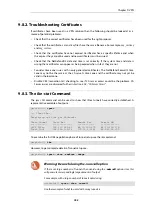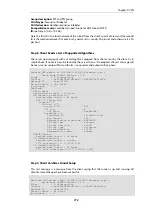
9.8. VPN Troubleshooting
This section deals with how to troubleshoot the common problems that are found with VPN.
9.8.1. General Troubleshooting
In all types of VPNs some basic troubleshooting checks can be made:
•
Check that all IP addresses have been specified correctly.
•
Check that all pre-shared keys and usernames/passwords are correctly entered.
•
Use ICMP
Ping
to confirm that the tunnel is working. With roaming clients this is best done by
Pinging the internal IP address of the local network interface on the NetDefend Firewall from
a client (in LAN-to-LAN setups, pinging could be done in either direction). If NetDefendOS is
to respond to a Ping then the following rule must exist in the IP rule set:
Action
Src Interface
Src Network
Dest Interface
Dest Network
Service
Allow
vpn_tunnel
all-nets
core
all-nets
ICMP
•
Ensure that another IPsec Tunnel definition is not preventing the correct definition being
reached. The tunnel list is scanned from top to bottom by NetDefendOS and a tunnel in a
higher position with the Remote Network set to
all-nets
and the Remote Endpoint set to
none
could prevent the correct tunnel being reached. A symptom of this is often an
Incorrect
Pre-shared Key
message.
•
Try and avoid duplication of IP addresses between the remote network being accessed by a
client and the internal network to which a roaming client belongs.
If a roaming client becomes temporarily part of a network such as a Wi-Fi network at an
airport, the client will get an IP address from the Wi-Fi network's DHCP server. If that IP also
belongs to the network behind the NetDefend Firewall accessible through a tunnel, then
Windows will still continue to assume that the IP address is to be found on the client's local
network. Windows therefore will not correctly route packets bound for the remote network
through the tunnel but instead route them to the local network.
The solution to this problem of local/remote IP address duplication is to create a new route in
the client's Windows routing table that explicitly routes the IP address to the tunnel.
•
If roaming client user authentication is not asking the users for their username/password
then ensure that the following advanced settings are enabled:
•
IPsec Before Rules
for pure IPsec roaming clients.
•
L2TP Before Rules
for L2TP roaming clients.
•
PPTP Before Rules
for PPTP roaming clients.
These settings should be enabled by default and they ensure that user authentication traffic
between NetDefendOS and the client can bypass the IP rule set. If the appropriate setting is
not enabled then an explicit rule needs to be added to the IP rule set to allow the
authentication traffic to pass between roaming clients and NetDefendOS. This rule will have a
destination interface of core (which means NetDefendOS itself ).
•
If the remote endpoint is specified as a URL, make sure that the URL string is preceded by the
prefix
dns:
. If, for example, the tunnel remote endpoint is to be specified as
vpn.example.com
,
this should be specified as
dns:vpn.example.com
.
Chapter 9: VPN
762
Summary of Contents for NetDefendOS
Page 30: ...Figure 1 3 Packet Flow Schematic Part III Chapter 1 NetDefendOS Overview 30 ...
Page 32: ...Chapter 1 NetDefendOS Overview 32 ...
Page 144: ...Chapter 2 Management and Maintenance 144 ...
Page 284: ...Chapter 3 Fundamentals 284 ...
Page 392: ...Chapter 4 Routing 392 ...
Page 419: ... Host 2001 DB8 1 MAC 00 90 12 13 14 15 5 Click OK Chapter 5 DHCP Services 419 ...
Page 420: ...Chapter 5 DHCP Services 420 ...
Page 573: ...Chapter 6 Security Mechanisms 573 ...
Page 607: ...Chapter 7 Address Translation 607 ...
Page 666: ...Chapter 8 User Authentication 666 ...
Page 775: ...Chapter 9 VPN 775 ...
Page 819: ...Chapter 10 Traffic Management 819 ...
Page 842: ...Chapter 11 High Availability 842 ...
Page 866: ...Default Enabled Chapter 13 Advanced Settings 866 ...
Page 879: ...Chapter 13 Advanced Settings 879 ...



































